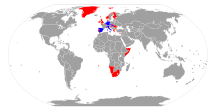4 meter tape
The 4-meter band (also known as the 4-m band or 80 MHz range ) is the frequency range from 68 to 87.5 MHz , which is used by operational , BOS radio and the Bundeswehr. Further areas of application are in train radio , in energy supply companies and in forestry . The frequency range is mainly used in frequency modulation (FM).
In the area of the former Soviet Union , part of the 4-meter band was also used as a normal radio band (see OIRT band ).
4 meter amateur band
In some countries, small areas in the 4 m band have been released for radio amateurs . Radio amateurs in the United Kingdom and the Netherlands can use the 70 to 70.5 MHz range.
In Germany, broadcasting was permitted from July 2, 2014 to August 31, 2014 in the frequency range 70.0 MHz to 70.030 MHz with a bandwidth of up to 12 kHz, horizontal antenna polarization and a maximum radiated power of 25 W EiRP.
In 2015 there was again a limited transmission license, this time in the range 70.15 to 70.18 MHz with 25 watt ERP. Communication No. 412/2015 was published on April 29, 2015 on the website of the Federal Network Agency and was valid until August 31, 2015.
Since December 19, 2018, broadcasting in the range from 70.150 MHz to 70.200 MHz has been approved again until the end of 2020. This was published in communication no. 414/2018 of December 19 of the Federal Network Agency and extended in 2020 with communication 8/2020. As in the previous permits, stationary operation is only permitted for holders of the class A permit. The transmission power is limited to a maximum of 25 W ERP and the antenna polarization must be horizontal. The bandwidth must not exceed 12 kHz.
The band plan was as follows:
| Frequency range | use |
|---|---|
| 70.000-70.050 MHz | Beacons (transmission mode undesirable) |
| 70.050-70.250 MHz | Narrow band modes
|
| 70.250-70.300 MHz | All modes of operation
|
| 70.300-70.500 MHz | All modes of operation; Channel spacing 12.5 kHz
|
4-meter tape Bundeswehr
| Frequency range | Channel number 20 kHz | use |
|---|---|---|
| 72.750-75.130 MHz | 600-719 UB | Subband (relay input) |
| 82.550-84.930 MHz | 600-719 OB | Upper belt (relay output) |
| Frequency range | Channel number 25 kHz | use |
|---|---|---|
| 72.750-75.225 MHz | 100-199 UB | Subband (relay input) |
| 82.550-85.025 MHz | 100-199 OB | Upper belt (relay output) |
In the Bundeswehr, the 4-meter radio is used domestically by non-combat units, for example by the Bundeswehr service centers , paramedics or the Bundeswehr fire brigade . The devices used are modifications of the BOS devices. They have the same device names (FuG-7, FuG-8 etc.), but use different frequencies according to the table above. Since the frequency ranges partially overlap on the 20 kHz devices, the BOS channels are shifted by 5 kHz in the grid.
4 meter BOS tape
| Frequency range | Channel number | use |
|---|---|---|
| 74.215-77.475 MHz | 347-510 UB | Subband (relay input) |
| 84.015-87.255 MHz | 347-509 OB | Upper belt (relay output) |

The frequency spectrum extends from 74.215 to 87.255 MHz, with a division into an upper band and a lower band , analogous to the 2-meter band .
The frequencies are distributed over 164 switchable channels (347-510), of which channels 377 to 396 are operated exclusively in the upper band, and channel 510 (channel for motor vehicle marches) exclusively in the lower band. The frequency offset ( duplex distance) between the upper and lower band is 9.8 MHz here. As a rule, the relay station transmits in the upper band, the vehicles and other units in the lower band. The traffic type two-way traffic is used for use with a relay station, and the traffic type alternating traffic is used for direct connections between two vehicles. Explanation of the different types and forms of radio communication can be found in the article Radiotelephone .
Radios for the 4-meter band are usually permanently installed in the vehicle (FuG 7b - FuG 8a or b), but handheld radios (e.g. FuG 13, FuG 13a, FuG 13b) are also used.
The radio call names in the 4-meter band differ from those in the 2-meter band, for more information see the article on BOS radio .
Web links
- Information about 4 meter amateur band (English)
- Information on the 4-meter amateur radio band (German)
- Official journal of the BNetzA published. Trials in the 4 m band are possible for a limited time. DARC e. V. , July 2, 2014, accessed September 4, 2014 .
Individual evidence
- ↑ Ofcom: UK Interface Requirement 2028. Amateur Radio Licenses - Foundation, Intermediate and Full Jan. 2007, p. 16.
- ↑ Regeling van de Minister van Economische Zaken, Landbouw en Innovatie van December 20, 2011, no. AT-EL & I / 662123 . In: Staatscourant . No. 23518, December 30, 2011, p. 6.
- ↑ Communication No. 502/2014 Amateur Radio Service; Limited access in the 70.00–70.03 MHz frequency range. ( PDF ) Federal Network Agency , July 3, 2014, accessed on September 4, 2014 .
- ↑ Communication No. 412/2015 Amateur Radio Service; Limited access in the frequency range 70.15 - 70.18 MHz. ( PDF ) (No longer available online.) Federal Network Agency , April 29, 2015, archived from the original on May 18, 2015 ; accessed on May 1, 2015 .
- ↑ Communication No. 414/2018 Amateur Radio Service; Limited access in the 70.15–70.20 MHz frequency range. ( PDF ) Federal Network Agency , accessed on November 3, 2019 .
- ↑ Communication No. 8/2020 Amateur Radio Service; Limited access in the 70.15–70.20 MHz frequency range. ( PDF ) Federal Network Agency , accessed on January 22, 2020 .
- ↑ Channel table FuG-7b-1, operating instructions for multi-channel radio devices, AEG-Telefunken, 1967
